

Gmail - Free Storage and Email from Google. Meet Google Drive – One place for all your files. Can the Flipped Classroom Benefit Low-Income Students? By Sarah Butrymowicz When Portland, Ore., elementary school teacher Sacha Luria decided last fall to try out a new education strategy called “flipping the classroom,” she faced a big obstacle.
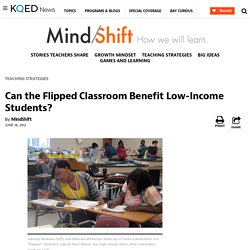
Flipped classrooms use technology—online video instruction, laptops, DVDs of lessons—to reverse what students have traditionally done in class and at home to learn. Listening to lectures becomes the homework assignment so teachers can provide more one-on-one attention in class and students can work at their own pace or with other students. But Luria realized that none of her students had computers at home, and she had just one in the classroom. So she used her own money to buy a second computer and begged everyone she knew for donations, finally bringing the total to six for her 23 fourth-graders at Rigler School. So far, the strategy is showing signs of success. “It’s powerful stuff,” she said, noting that this year was her most successful in a decade of teaching. The Flipped Classroom. Preparing Students for a Flipped Classroom.
What a 'flipped' classroom looks like. Introducing The Flipped Classroom. The Flipped Classroom Model. Flipped-Learning Toolkit: 3 Ways to Take Your Students Deeper. Editor's Note: This post was co-authored by Aaron Sams, Managing Director of FlippedClass.com and founding member of the Flipped Learning Network.
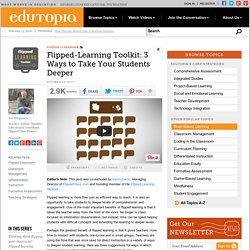
Flipped learning is more than just an efficient way to teach. It is also an opportunity to take students to deeper levels of comprehension and engagement. One of the most important benefits of flipped learning is that it takes the teacher away from the front of the room. No longer is class focused on information dissemination, but instead, time can be spent helping students with difficult concepts and extending the learning to deeper levels. Student Perceptions of the Flipped Classroom – New Research. We’re always interested to hear about new research into flipped learning and we recently caught up with Graham Johnson, a high school teacher at Okanagan Mission Secondary in British Columbia, Canada.

He’s just completed a Master of Arts in Educational Technology investigating student perceptions of the flipped classroom (congratulations Graham!). Graham has been teaching maths for six years. Two years ago he decided to flip his classroom and, when he started his masters degree at the University of British Columbia it was an obvious topic to research for his thesis. The research focused on what students feel about the flipped classroom and posed the following questions: 10 Pros And Cons Of A Flipped Classroom. 10 Pros And Cons Of A Flipped Classroom by Mike Acedo Many of us can recall instances in our lives where we found ourselves idly sitting in a classroom, eyes glazed over, half listening to our teacher as they lectured in front of the room.

These scenes are all too familiar in today’s schools, as the traditional model of learning has primarily revolved around a teacher-centered classroom, where instructors focus on conveying information, assigning work, and leaving it to the students to master the material. The Flipped Classroom Guide for Teachers. As technology becomes increasingly common in instruction at all levels of education from kindergarten to college, the modern classroom is changing.
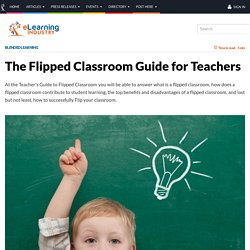
The traditional teacher-centered classroom is falling away to give students a student-centered classroom where collaborative learning is stressed. One way educators are effectively utilizing online learning and changing the way they teach is by flipping their classrooms. What Is A Flipped Classroom? In the traditional classroom model, teachers first explain each topic, and then assign homework.
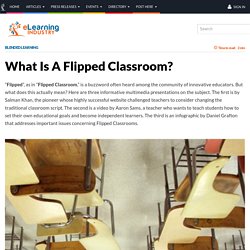
In the flipped classroom model, students first view the topics outside of class, and then use class time for inquiry-based learning, which in some ways resembles traditional homework assignments. A flipped or reversed classroom uses educational technologies to leverage valuable classroom time. Once students have covered material traditionally covered in lectures outside of the classroom, teachers can focus on learning-based activities in the classroom, and also deliver more one-on-one, customized assistance. In the following video, Salman Khan discusses how and why he created the remarkable Khan Academy, a carefully structured series of educational videos.
Khan Academy began many years ago as an extensive series of videos covering a broad math curriculum. Jon Bergmann and Aaron Sams – FlippedClass.com. Jon Bergmann is a pioneer of the Flipped Class movement, Chief Learning Officer of FlippedClass.com, and co-founder of The Flipped Learning Network.

He co-wrote the books, Flip Your Classroom: Reach Every Student in Every Class Every Day and Flipped Learning: Gateway to Student Engagement. Throughout Jon's twenty-four years as a high school science teacher, he guided his teaching with one overriding concern: what is the best use of face-to-face class time? As a result of Jon's innovation and tenacity, he received the Presidential Award for Excellence for Math and Science Teaching in 2002 and was named Semi-Finalist for Colorado Teacher of the Year in 2010. He co-founded The Flipped Learning Network™ ( FlippedLearning.org ), a nonprofit organization which provides teachers with the resources needed to implement flipped learning.
Flip handout fnl web. Everything Teachers Need to Know about the Flipped Classroom. Flipping the classroom when home access is a problem. A lack of reliable internet access at home can make flipping a challenge, but by no means an impossibility Ed. note: Jess Peterson will co-present a related session, “Flipping the Classroom in Low-Socioeconomic Schools,” at this year’s FETC conference in Orlando, on Friday Jan. 15.
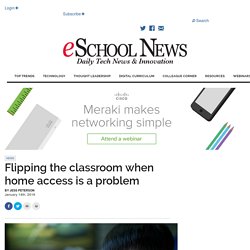
Ask any educator, and they’ve probably at least heard of flipping the classroom. There are articles for days about the benefits and rewards to be reaped from flipping. Plenty of teachers have given it a go, or at least considered it. Too many teachers have ruled it out on account of their students’ lack of access. It’s true that our students come from all walks of life. Believe it or not, flipping the classroom can actually help close this gap. The Barriers of Flipping the Classroom Life is full of barriers.
Students don’t have consistent access to devicesStudents don’t have consistent access to InternetStudents don’t have skills to use the technology Understand the benefits.